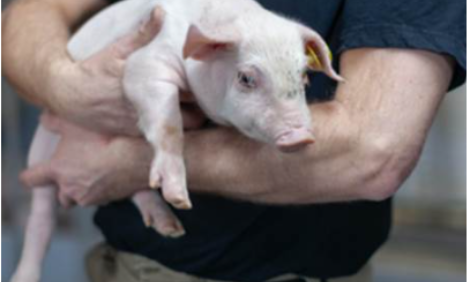



A Quick Test for Classical Swine Fever
By Kayla Duffield, Ontario Pork Newsletter. A Quick Test for Classical Swine Fever that will help keep foreign markets openCanadian swine herds have been free of swine fever for over 40 years. Rigorous tests have been key to Canada's assurances, and have helped keep foreign trade doors open - but they can be expensive and time consuming. Now, Dr. John Pasick of the Canadian Food Inspection Agency is developing a test that will be faster and easier to administer.
"Our trade partners want proof that we have no instances of swine fever in Canada," says Pasick. "This tool should help do that more effectively and contribute to Canada's strong track record."
Pasick is in the first of a three-year phase for developing the test. His work is based on a technique called an Enzyme-Linked ImmunoSorbent Assay (ELISA) that can analyse a blood sample for the presence of antibodies that are produced as part of the immune response to a disease such as the swine fever.
In his work, Pasick has used a number of different strains of the swine fever virus to isolate a major surface protein. This protein was then expressed in another virus and used to coat an ELISA plate.
In the next phase, blood samples from pigs are applied to the ELISA plates that have been coated with the different proteins. Any antibodies present in the blood will bind to the surface proteins that they are specific to on the plate. Doing this will reveal if the pig has developed any antibodies against a particular virus strain, Pasick says. If the pig has no antibodies, the plates will be boldly coloured from the interaction; if the pig has antibodies, a weaker colour will occur. From this, Pasick can determine if an animal is positive for the classical swine fever virus.
Before the test becomes widely available, Pasick must validate its effectiveness in laboratory and field trials. The test must be found to consistently detect all the genotypes of the virus. It must also detect 200 to 300 positive test results before it can be considered valid, he says.
When the test is completed and validated it is hoped that provincial labs across Canada will use it as a faster, more efficient method to detect infected pigs. Other tests are commercially available in Europe but require an import permit to be used in Canada. Other tests used for detecting antibodies for swine fever virus can take several days to obtain results, while tests designed to isolate the virus can take up to a month to obtain results. None of these are high throughput.
By using the ELISA technique, Pasick's test can produce results within three hours. This allows for a high throughput of animals for testing, and means there is a reduced time period between infection and confirmation stages, which is critical for early detection and elimination of the virus before its spread.
Canada currently has barriers in place to keep classical swine fever out of the country, says Pasick, including not importing pigs or pork products from countries that are positive for the disease. Despite these barriers, there is still a risk that the disease can enter Canada through illegal markets and imports. This new detection tool will provide another monitoring device so producers can continue to be vigilant against the disease.
"This is a disease we want to keep out of Canada," says Pasick.
Pasick's research is funded by the Canadian Food Inspection Agency, Alberta Agricultural Research Institute and Ontario Pork.








